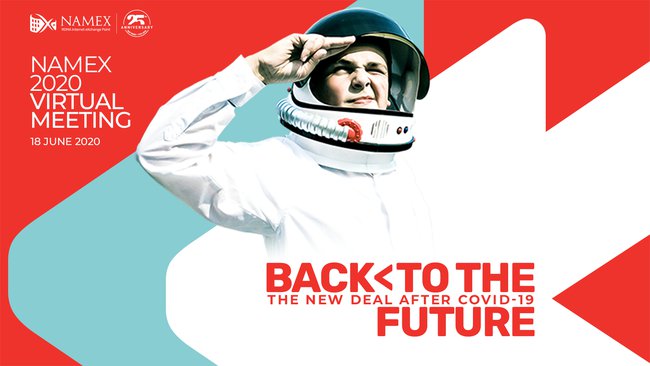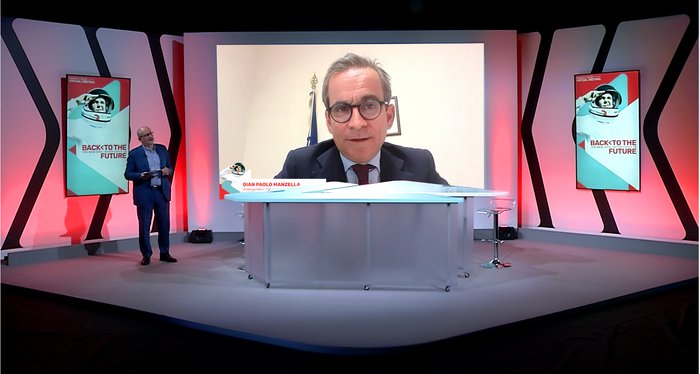Lessons Learnt - Organizing a Virtual Event
Member News - Namex - 5 October 2020


The Namex Annual Meeting has kept growing year after year, gaining great importance within the Italian and International community. Moreover, this year we were planning a special edition, to celebrate the 25th anniversary of the creation of the Roman NAP.
Because of the COVID-19 situation, it was an intense and totally new experience. We did not want to lose the schedule that was well known and appreciated by the attendees, with a plenary session in the morning and the One-to-One meetings in the afternoon. However, we also felt that we needed to offer something different in this new situation to increase involvement.
We decided to organize the plenary session from a TV studio, with a public streaming of the whole morning conference. The TV studio was not only the location, but the real core of the event. We had a presenter to set the rhythm and, like in every TV show, we also had advertisement breaks.
The commercials have been crucial, not only because of the financial support from our sponsors, but especially because they helped keep a high attention and participation during the event. In fact, our event was somewhat long, when compared to the average of online events; we started at 10:00 in the morning and finished at 19:00 in the evening, after an intense workshop session.
At the end of the day, we had more than 670 unique sessions during the morning plenary, with 496 registered attendees from 278 companies. This is by far the all-time record for a Namex Annual Meeting. Our workshop session, held in the afternoon, was also very successful. We managed to schedule 11 workshops and measured an average attendance of 60 participants. The workshop session has shown to be a great opportunity to combine a high-level technical session with the need to give adequate visibility to the sponsors, since they could not benefit from the traditional dedicated areas of a live event.
We also organized our traditional One-to-One session online, leveraging on the built-in videoconference feature within Meeting Mojo, the tool that we chose to schedule and hold the bilateral meetings. We had 300 participants and 120 video meetings in this session.
The plenary session participants have more than doubled compared to the previous year, confirming that there is a huge gap between the people interested in our event and the people that can actually attend in person.
The success of this virtual format suggests that the online session is an added value to the event and should not be considered as a mere emergency solution. The web stage allows us to increase the number of participants and reach an additional audience of people that cannot be present in person at the event. The recording also allows to recover those parts that are missed because of conflicting engagements (be it at the event location or remotely) and to reach an additional small group that becomes interested after the fact because of the word of mouth spread of the interest raised by the topics or the presenters.
For us as an IXP reaching a larger audience is more than vital as this is the first step to involve new active members. We are looking forward to organizing our next event in person but are also planning to keep the online streaming so that we can strengthen and enlarge the Namex and the Italian Internet communities.
As we would highly recommend other IXPs to follow our steps, here are some key points on the lessons learnt organizing a virtual event.
1. Use a TV studio; Organizing a virtual meeting is quite different from organizing a traditional event, especially because of the fragmentation of the attendees’ experience. We decided to use a TV studio so that we could manage the speakers as if they were on a real stage. The TV style helped a lot to keep the concentration during the whole session and it was surely an added value for the quality of the experience.
2. Have video standards for the speakers; Almost all our speakers were connected on Zoom. Since everyone is connecting from a different place there might be issues in the image quality, such as untidy backgrounds or bad lighting. We had our team of video professionals prepare an essential handbook so that every speaker could easily set up his workspace.
3. Interaction; This is for sure the most challenging and important part while organizing an online event. The fact that the attendees are not together in the same room is a major issue for interaction. We decided to go online with a live streaming instead of Zoom so that we could provide a high-quality experience. We interacted with our audience using Sli.Do, like we did in our previous events and the feedback was positive. For the future, we will definitely think to do something different to make it possible for the attendees to interact with each other, besides interacting with the speakers and presenter.
4. Non-stop communication; It might come as a surprise the amount of information that needs to be communicated in advance for a virtual meeting. The fact that there is no physical location, and therefore no welcome desk, requires a higher commitment in communicating everything before the meeting, such as links, timing, how to join the conference/workshop rooms.
We hope that our experience can be of help and inspiration to others in the community and look forward to hearing of different experiences and new lessons learnt!
Namex
More Member News




